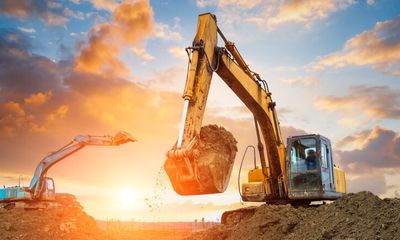© 2025 Powered by Antbuildz.com
© 2025 Powered by Antbuildz.com


We have written about Singapore Maritime Status and Why Mega Tuas Port is matters to Singapore in the previous article. You can read the article here.
By now the phase 1 Mega Tuas Port already completed installing a total of 221 caissons and set to complete the entire reclamation work by 2021 with about 2,000 workers and supervisors on site. Meanwhile, the second phase already commenced.
Mega Tuas Port is a mega port that built to receiving container vessels up to 24000 TEU with 24M water depth. It's meant by the time it starts operation, the port can receive any size of cargo vessel in the world. That is the reason why Mega Tuas Port will become the largest port in the world.
Learn the introduction of all Important Construction Equipment.
Maritime and Port Authorities of Singapore or MPA is constructing the port by Caisson Technology.
Caisson construction, also known as caisson foundation, is a water-retaining structure that is mainly used in construction projects that take place underwater. Caissons are prefabricated cylinders or hollow boxes that are sunk to the desired depths beneath oceans, rivers, and other water bodies. They are then filled with concrete to create a solid foundation for the project, serving as an anchor. Structures such as concrete dams and bridge piers generally require a caisson as a base.
The technology is not new and already been used since ancient for port infrastructure construction. For Mega Tuas Port, Caisson will be installed for the breakwater, to form the seawall for reclamation work.

The use of caissons in Phase 1 is a safer and more efficient method of reclamation compared to traditional methods such as piling. In fact, the method will be used for the remaining 3 phases as well. The caissons used for Tuas Terminal’s construction are one of the largest in the world. Pre-fabricated onsite, the caissons each weigh 15,000 tonnes and measure 40m in length, 28m in width, and 28m in height – as tall as a 10-story building. Besides that, it is much faster than any other method to construct a port.

Above graphic shown a methodology of how the seawall constructed to form the perimeter of the port. The perimeter watertight seawall will then break off the water from the sea and internal of the caisson wall. The reclamation of the land inside the wall will then carry out.
To lay the caisson to form the seawall, a rock mound layer of foundation on the seabed need to be constructed.
“TEMAROCK is a next-generation all-in-one rock mound construction vessel. The conventional process of rock mound construction requires multiple vessels for rock laying and compaction, one survey vessel to facilitate operation, and is supported by divers. TEAM ROCK automates these tasks, eliminating the need for multiple vessels or divers’ assistance. This enhances efficiency and safety.”

On the other hand, the fabrication of the caisson will be carried out concurrently.
For Mega Tuas Port, 2 caisson fabrication yard has been constructed side by side to fabricate 2 caisson at the same time to speed up the construction schedule. (Some other port projects do casting of the caisson on the floating dock.)
“The fabrication of caisson requires a large number of rebar sections, to coupe with the amount of volume, advance technology, Automatic Rebar Machine using Robotics System (ARMS) has been used. ARMS automates the bending and cutting of reinforcement steel bars (or rebars, which are used to strengthen concrete) to the desired design, and then transfers them onto the stacking area. The conventional practice requires workers to handle the rebar manually, which exposes them to mechanical hazards when they operate the rebar cutting and bar bending machines. “

After the caisson installed, the internal area of the caisson seawall will be reclaimed to form solid land. Subsequently, the terminal will be built with the installation of port equipment and facilities.
The project also illustrated the re-using of materials such as excavated earth from land construction projects as an eco-friendlier approach. This, MPA said, reduces the quantity of sand required for reclamation by around 70 percent for Phase 1 and 50 percent for Phase 2. MPA expects to achieve cost savings of around S$2 billion.
Here is our little sharing of how is the port will be constructed. You can see the interesting video of Phase 1 construction below.
Remember to like and share our Facebook page!bit.ly/34MdSFh, we will share a more interesting article with you.
We are the first intelligent digital platform in Singapore set to reinvent the traditional construction equipment rental into a touchless equipment rental experience. Learn more with us!
Any Questions?
WhatsApp or Call Us for a FREE consultation on the most suitable equipment for your site. We’re more than happy to assist!
Related Articles

Top 5 Common Construction Safety Issues & Mitigation Plans in Construction Industry
Construction sites are dangerous places. Some of the dangers, such as heavy cons ...
Learn more
22 Jan , 2025

Tips to be a Good Engineer in Construction Industry
Typically, it takes you 4 years to complete your degree in university to acquire ...
Learn more
22 Jan , 2025

Every Part You Need to Know About Excavator
PARTS OF AN EXCAVATOR Excavators are the most common equipment used in construct ...
Learn more
22 Jan , 2025

Antbuildz.com Was On The News!
This is certainly a historical milestone for us, and what seems to just be the b ...
Learn more
22 Jan , 2025